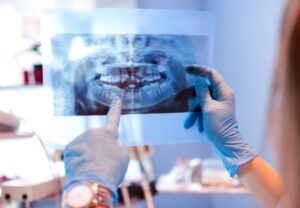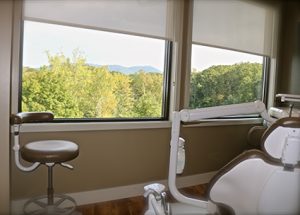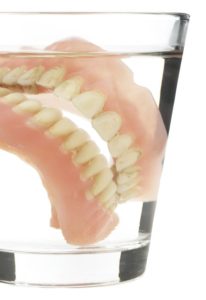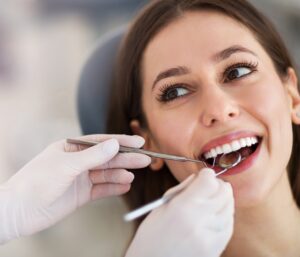Header logo
header top contact widget
Dry Mouth
Smoking, Vaping Lead To Gum Disease, Tooth Loss.
Posted on Sep 15, 2020 by William J. Claiborne, DDS MS
With all good intentions, adults occasionally trade one bad habit for another. For instance, a commitment to exercise more often for weight loss can easily backfire when justifying a thick smoothie as a daily reward.
This is what worries me about Vaping. Vaping, the use of e-cigarettes, hit the market around 2007. It is designed to deliver nicotine through a vapor. Although the vapor is generally not labeled as harmful (it’s not “safe”, either), its nicotine is no less harmful to the user as that delivered via cigarette smoke.
Unfortunately, many cigarette users switched to vaping based on the perception that “e-cigs” were a safer alternative. For those who wanted to wean themselves off of cigarettes through this switch, very few achieve that goal as a result.
A 2018 report by the National Academy of Sciences, Engineering, and Medicine concluded there was “evidence that e-cigarette use increases the frequency and intensity of cigarette smoking in the future.”
Teens have been most susceptible to the hazards of vaping. It is the most commonly used tobacco product among U.S. youth. E-cigarette use among middle and high school students increased 900 percent during 2011-2015. According to the Surgeon General, 1 in 5 high school students and 1 in 20 middle school students were using e-cigarettes in 2018.
Unfortunately, nicotine exposure can harm the brain as it develops, until about age 25. During adolescence, nicotine use can affect learning, memory and attention span as well as increase their risk for future drug addictions. (https://e-cigarettes.surgeongeneral.gov/documents/surgeon-generals-advisory-on-e-cigarette-use-among-youth-2018.pdf)
As a periodontist in Asheville, NC, my concern when it comes to oral health is what many cigarette smokers and vapers don’t realize when it comes to high risks to their smiles.
In our periodontal dental office, I’ve seen how significantly the habit of cigarette smoking can have on one’s smile. It’s no secret that smoking cigarettes can stain teeth and cause bad breath. However, nicotine in any form is a hazardous force in the mouth.
According to the American Dental Association (ADA), smoking can cause the gums to recede from teeth, exposing vulnerable tooth root sections. This enables easier entry of oral bacteria into the structures that support tooth roots. Smoking can also delay healing following periodontal therapy, extractions or implant placement. The longer it takes oral tissues to heal, the greater the risks for infection to develop.
Additionally, smoking increases the risks of oral cancer, lesions inside the mouth, periodontal (gum) disease, enamel erosion and tooth loss. It greatly reduces saliva flow in the mouth, which is a tremendous aid in removing bacteria and food particles from the mouth, helping to control bacteria levels. The condition of “dry mouth” also causes bad breath.
Because of the vape’s moist presence in the mouth, the assumption with vaping over smoking cigarettes is the “benefit” of oral dryness. However, this is easily dispelled when looking at the true facts.
While there are more than 7,000 chemicals found in the smoke of tobacco products, (including nicotine, tar, carbon monoxide, acetaldehyde and N-nitrosamines), nicotine is the primary addicting component. A study of some e-cigarette products found the vapor contains known carcinogens and toxic chemicals, as well as potentially toxic metal particles from the device itself.
The e-liquids delivered by these devices typically contain nicotine, propylene or polyethylene glycol, glycerin, and additives. Sound safe? Not at all.
According to the Centers for Disease Control & Prevention (CDC), a smoker has twice the risk for gum disease compared with that of a nonsmoker. (https://www.cdc.gov/tobacco/campaign/tips/diseases/periodontal-gum-disease.html)
When a patient is diagnosed with advanced periodontal disease (periodontitis), they must make a commitment of time and expense to rid this inflammatory disease from their mouths. For those who ignore its presence or assume it will get better on its own, the disease will simply progress further.
Gum disease begins with sore gums that may bleed while brushing teeth. Or, it may cause no noticeable symptoms at all in early stages.
As it worsens, gum disease will cause frequent bad breath, tender gums that turn red, gum recession, and gums that bleed easily when brushing. Pus pockets may form on the gums. As it attacks the structures beneath the gum line, teeth may loosen or shift.
As the nation’s leading cause of adult tooth loss, it brings the hard decisions (and expense) for replacement. After all, you need teeth for eating and speaking. Do you go with dental implants? Or, do you take on the challenges that come with dentures and partials? As hard as the decisions of replacing teeth can be, gum disease can bring even more devastation with it.
Research has linked the bacteria of gum disease to serious health problems. These include heart disease, stroke, preterm babies, arthritis, diabetes, impotency, some cancers and even Alzheimer’s disease. These connections occur through the infectious bacteria of gum disease entering the bloodstream through tears in diseased gum tissues.
Once in the bloodstream, the bacteria can travel throughout the body and create inflammatory reactions. This “systemic inflammation” is able to trigger the onset of some diseases and conditions or even further the development of others.
Certainly, we all have the right to determine what is in our best interest as far as our own health goes. However, I believe that many individuals end up in our office with serious gum problems and facing tooth loss because of what they did not know. Having factual information allows us to make wise decisions for our health and well-being.
As a periodontist, I have advanced skills in the treatment of all stages of periodontal (gum) disease. My dental specialty also includes the diagnosis and placement of dental implants. Here, our patients can relax under Oral or IV sedation (“twilight sleep”) while having their smiles restored. We also create a customized care program that allows each person to maintain good oral health once their treatment is complete.
 If you smoke or vape, don’t assume “that won’t happen to me.” The reason we wear seat belts in cars is because there are great risks when we do not. The risks for losing your teeth and having potent bacteria running rampant through your system is something you can take easy measures to prevent.
If you smoke or vape, don’t assume “that won’t happen to me.” The reason we wear seat belts in cars is because there are great risks when we do not. The risks for losing your teeth and having potent bacteria running rampant through your system is something you can take easy measures to prevent.
Experiencing symptoms associated with gum disease? We urge you to schedule an examination appointment as soon as possible. Call our beautiful, comfortable Asheville office at 828-274-9440. A referral is not necessary.
How To Avoid Thinning Jaw Bones That Cause “Granny Look”
Posted on Sep 10, 2020 by William J. Claiborne, DDS MS
Imagine your mouth begins to sink into your face. Deep wrinkles form around your mouth and the corners of the mouth begin to turn downward, even when you smile. Jow ls form, allowing skin to seem to loosen and hang on both sides of the face. The chin becomes more pointed and the nose and chin get closer and closer.
ls form, allowing skin to seem to loosen and hang on both sides of the face. The chin becomes more pointed and the nose and chin get closer and closer.
This sounds pretty awful. It is like a disfigurement of the face. It’s not a horror movie, though. This is real, caused by one of the most preventable of all diseases afflicting American adults. It’s a disease that affects over 47 percent of all adults over the age of 30. For adults over the age of 65, the figure rises to over 70 percent. (https://www.cdc.gov/oralhealth/conditions/periodontal-disease.html)
Amazingly, this highly prevalent disease is simply periodontal disease. Often referred to as gum disease, some people also refer to it as “perio.” These are fairly familiar terms when it comes to what adults endure. Yet, it seems to be easily ignored, which merely allows it to progress further.
Before we get into the causes (and easy prevention measures) of gum disease, let’s examine how the dreaded changes in facial appearance are related to it.
Gum disease is the nation’s leading cause of adult tooth loss. Assumed to be a normal part of the aging process, it is anything but. Yes, older adults are more prone to acquiring gum disease due to a reduction in saliva and perhaps being less efficient at oral hygiene. But losing teeth can be prevented, and should be.
The problem with losing natural teeth has to do with their roots. It is the roots of a tooth that serve a much greater purpose than most people realize. While the appearance and function of dentures and partials (albeit reduced) can be replaced, they do nothing to replace what is lost beneath the gum line.
Simply put, the lack of tooth roots is the beginning of a “melting face.” This leads to bone loss and is known as resorption. Resorption is the shrinking of the bone structures that support teeth. As tooth roots are absent, the loss of bone mass can create a number of problems – both related to oral health and in facial appearance.
Tooth roots are a living part of your skeletal structure. Tooth roots are what provide nourishment and stimulation to the jaw bones. This helps the jaws to maintain a healthy mass. When tooth roots are removed, the bones slowly begin to shrink. Although most people don’t notice anything different for a while, bone loss begins almost immediately.
As described at the beginning of this article, there is a ‘look’ of bone loss, which causes changes in facial structures. This is because the bone mass is shrinking. As it shrinks, muscles detach and facial skin hangs looser.
Initially, you may only notice more wrinkles around the mouth. As it worsens, you may realize your chin seems to be more pointed. The extreme visual change of bone resorption is referred to as a ‘granny look.’ This causes people to appear far older than their actual age.
For those who wear a denture or partial, losing jaw bone mass also causes a change in the way the denture or partial fits. For example, a denture may fit fine the first year after teeth are removed and a denture is fitted. However, you’ll eventually notice slips when biting or chewing. This is because the bone under the “arch” that supports the denture or partial is declining in height.
The changing foundation for the denture allows it to “slip” or become “wobbly.” As bone loss continues, you may experience uncomfortable rubbing on tender gum tissues while eating. You may start to bypass foods that require rigorous chewing, opting for softer foods that dissolve quickly in the mouth. Outings with friends and family seem to be overshadowed by the fear of embarrassing slips.
Eventually, even frequent applications of denture pastes or adhesives are of little help. A reline may be recommended by your dentist to reshape your denture or partial to fit the reduced contours of the gum ridge (or “arch”). Continued bone loss will require yet another reline as the ridge flattens further.
Denture wearers are typically unaware that the pressure on the gums from wearing a denture accelerates the rate of bone loss. For those who sleep in their dentures, this means that pace of bone loss occurs 24/7.
Sleeping in a denture can also add to higher risks for the flu and pneumonia. A 3-year study of more than 500 adults was published by the Journal of International Oral Health. Of the 186 (of 453 denture wearers) who did not remove their dentures for sleeping, they had over twice the risk for pneumonia than those who did. Sleeping in dentures also led to higher levels of tongue and denture plaque, gun inflammation and other oral issues.
(https://www.ncbi.nlm.nih.gov/pmc/articles/PMC4295446/)
When it comes to replacing natural teeth, there are many reasons we recommend dental implants, a major advantage being their ability to halt bone loss. Because dental implants act as replacement tooth roots, they are able to restore stimulation to the jaw bones.
Additionally, dental implants use the same, sturdy foundation as natural teeth once had. This means you can bite and chew the foods you love (including that thick steak) without fearing embarrassment or uncomfortable rubbing against tender gum tissues.
Dental implants are also designed to last a lifetime, making them a wise investment.
A particular skill of the periodontal specialty is the advanced training in the diagnosis and placement of dental implants. This training allows the specialist to determine the best dental implant type for your needs. A periodontist can also enhance your outcome through proper placement.
If you are missing natural teeth or have become frustrated with a denture or partial, call 828-274-9440 for a consultation in our Asheville periodontal dental office. During this time, we can discuss the implant system that may be most appropriate for your needs. I’ll also be happy to explain the procedural process, comfort options, and easy payment plans.
For a smile that looks beautiful and functions to support good health, don’t let the detrimental effects of dentures lead to a “granny look”. Dental implants can help you enjoy a confident, worry-free smile through your lifetime.
How Menopause Can Put Oral Health At Risk
Posted on Aug 31, 2020 by William J. Claiborne, DDS MS
According to the Mayo Clinic, “Menopause is the time that marks the end of your menstrual cycles. It’s diagnosed after you’ve gone 12 months without a menstrual period. Menopause can happen in your 40s or 50s, but the average age is 51 in the United States.” (https://www.mayoclinic.org/diseases-conditions/menopause/symptoms-causes/syc-20353397)
 Physical symptoms of menopause can include hot flashes, night sweats, fatigue and moodiness. Hot flashes typically last about two years, but for 15 – 20 percent of women, they never go away. Insomnia or sleep disturbances may can also continue unless the woman takes hormones or other medications.
Physical symptoms of menopause can include hot flashes, night sweats, fatigue and moodiness. Hot flashes typically last about two years, but for 15 – 20 percent of women, they never go away. Insomnia or sleep disturbances may can also continue unless the woman takes hormones or other medications.
Now, add to this findings of research that shows post-menopausal women are at high risk for tooth loss.
Studies have revealed that bone loss in postmenopausal women can be accompanied by a greater risk for periodontal (gum) disease. A study published by the National Institutes of Health cited that post-menopausal females with signs of osteoporosis had an increased risk of gum disease when compared to post-menopausal women with no signs of osteoporosis.
It has long been known that a reduction in estrogen levels contributes to bone loss. According to the web site of the American Academy of Periodontology, challenges may go further:
“Women who are menopausal or post-menopausal may experience changes in their mouths. They may notice discomfort in the mouth, including dry mouth, pain and burning sensations in the gum tissue and altered taste, especially salty, peppery or sour.
“In addition, Menopausal Gingivostomatitis affects a small percentage of women. Gums that look dry or shiny, bleed easily and range from abnormally pale to deep red mark this condition. Most women find that estrogen supplements help to relieve these symptoms.” (https://www.perio.org/consumer/gum-disease-and-women)
Decreases in estrogen due to menopause also increase the risk for heart disease and Alzheimer’s disease. While hormone replacement therapy (HRT) can alleviate symptoms associated with estrogen deficiency, replacing estrogen may also prevent some of the chronic illnesses common to postmenopausal women.
At our Asheville periodontal office, we structure each patient’s care according to individual aspects of both oral and overall health. In addition to careful review of a new patient’s health history and medication list, we request any updates to the information at each visit. This allows us to customize your care so your treatment needs are minimized.
Periodontists receive extensive training in the diagnosis and treatment of gum disease and in dental implants, including three additional years of education beyond dental school. They are familiar with the latest techniques for diagnosing and treating periodontal disease, and are also highly-skilled in performing cosmetic periodontal procedures.
If you are post-menopausal, be particularly aware of the signs of gum disease. These include gums that bleed when brushing, sore or tender gums, receded gums that expose darker tooth root sections, gums that darken in color, persistent bad breath or pus pockets that form at the base of some teeth.
Call 828-274-9440 to schedule an examination at your earliest convenience. These symptoms will not improve without treatment. Delayed treatment may also result in more extensive treatment needs in the future.
Although a referral by a general dentist or another dental specialist is not required, we encourage patients to develop a relationship with a generalist in order to maintain a healthy smile on an ongoing basis.
If you have already experienced tooth loss, remember that a periodontist also specializes in the placement of dental implants. This dental specialist can help to restore the health of your smile as well as the look and function.
Afraid Of The Dentist? Let’s Help You Get Past That For A Healthy Smile!
Posted on Jul 22, 2020 by William J. Claiborne, DDS MS
By some estimates, having a fear of dental visits affects over 70 percent of American adults. When people are afraid of going to the dentist, many often do not receive the regular care necessary to maintain a healthy smile.
As an Asheville Periodontist, I find that the origin of many who develop periodontal (gum) disease is from fear associated with dental visits. It is not unusual for a fearful dental patient to avoid going to the dentist for years, only ‘giving in’ when something becomes so painful they can no longer delay treatment.
We know that when it comes to dental fear, different people have different levels. Some patients are very relaxed in our office from the moment they walk in and throughout treatment. Others are fine until they are seated in the treatment chair. Still, others are anxious throughout their visit.
A study published by the Dental Research Journal revealed nearly 59 percent of 473 adult participants had dental fears. The study included males and females of varying ages and education levels. Although females presented a higher likelihood for dental fear, there was very little difference elsewhere. What did stand out, however, was how many had experienced traumatic dental episodes.
Unfortunately, a traumatic experience in a dental chair with a too-rough dentist tends to remain in the subconscious forever. Many fears are the result of a frightful experience as a child, feeling helpless and afraid. Such an experience tends to make an indelible mark on the subconscious and resurface whenever a dentist or dental office comes to mind.
If you experience these feelings associated with dental visits, there is nothing ‘wrong’ with you. However, delays in care can allow small problems to become more complex, requiring more involved treatment.
Many high-fear patients only force themselves into a dental chair when they are in such pain that they have no choice. It is far easier for adults to find a way to have regular exams and cleanings to prevent emergency needs. This begins by finding the right dental office.
Until then, regular dental check-ups are something that can’t be duplicated at home. Even a thorough, daily brushing and flossing routine misses bacteria on occasion. Within the course of just 48 hours, oral bacteria can form a cement-hard colony attached to tooth surfaces. This accumulation of bacteria eats away at tooth enamel and gum tissues.
As oral bacteria consume gum tissues, inflammation begins. This is gingivitis, the initial stage of gum disease. In this, the gums are tender and occasionally bleed when brushing. As gingivitis progresses to periodontal disease, symptoms include persistent bad breath and gums that turn red versus a healthy pink color. Gum tissues may begin to recede, exposing sensitive areas of tooth roots.
Eventually, the infectious bacteria will attack further beneath the gum line. This inflammation leads to damage to the bone structures that support tooth roots. Pus pockets may form on gums and teeth may loosen. To no surprise, periodontal disease is the nation’s leading cause of adult tooth loss.
This infectious bacteria doesn’t just remain in the mouth. Through tears in weakened gum tissues, it can enter the bloodstream. It’s presence can trigger inflammatory reactions that have been linked to heart disease, stroke, some cancers, preterm babies, arthritis, diabetes, erectile dysfunction (ED), and impotency. Some studies are showing a correlation to Alzheimer’s disease.
What we often find with high-fear patients is their assumption that good at-home care can take the place of their regular care visits. However, even a diligent home-care routine leaves them susceptible to oral bacteria. A number of factors heighten vulnerability to bacterial accumulation, including dry mouth and diet.
Dry mouth occurs due to a wide range of factors. Some medications have a drying affect on the mouth. Certain foods and beverages contribute to dry mouth, especially those containing caffeine and alcohol. Smoking is very drying to oral tissues. And, the aging process leaves us with drier mouths.
Eating sugary foods and many carbohydrates are just as detrimental to oral health. Many Americans snack during the day, often on chips, crackers and candy bars – which are then washed down with sugary sodas. All this converts into a sugar based super-food in the mouth that provides oral bacteria with sustenance that super charges their reproduction.
How does a fearful adult overcome the problem so they can have the dental care they need?
In our office, patient comfort is a priority at every visit. We have even designed our reception area to pamper you from the moment you enter. Patients in this area can enjoy a selection of gourmet coffees, cable television and WIFI connection. The seating is comfortable and our front office staff are attentive to your needs.
We offer a private consultation room for patients as well. In this room, we can discuss treatment and answer questions in a comfortable setting. This allows patients to become better informed about their treatment needs and options versus communicating while they are seated in a treatment chair.
Our surgical suite offers a rather unique setting for a periodontal office. A large window provides beautiful mountain views, very soothing to our patients. In addition, we offer oral sedation as well as I.V. sedation (twilight sleep) for most procedures, if desired.
Oral sedation is a pill that helps patients relax. It also has an amnesiac effect, leaving most with little or no memory of treatment afterward. I.V. sedation places the patient in a deeper sedative state, also erasing memory of the procedure. It is administered by a doctor of anesthesiology for optimal comfort and safety. With both, patients are monitored with advanced safety equipment throughout treatment.
Our patients also find our entire staff is a unified team who reflect sincere compassion and commitment to exceptional, comfortable care. While the doctors involved in your care are all top-notch, I must admit that our staff are the pros at making our patients feel truly pampered.
When patients realize that our goal is to provide exceptional care and comfort, most relax. This creates a sense of trust that causes many to no longer perceive dental care as dreaded, frightening events. Once the obstacle of fear is replaced with feelings of trust, the process to achieve a healthy, confident smile becomes a much easier one.
If you or someone you know has fear that has prevented dental care, the possibility of gum disease is pretty high. We suggest beginning with a consultation appointment, which occurs in our private consultation room. This is removed from the clinical area and provides a relaxed setting where patients can share their unique needs and concerns.
Call 828-274-9440 to schedule or learn more. I’m sure you’ll find our friendly telephone staff is welcoming and reassuring from the very first conversation.
Recent Posts
Categories
Archives
- September 2024
- August 2024
- July 2024
- June 2024
- May 2024
- April 2024
- March 2024
- February 2024
- January 2024
- December 2023
- November 2023
- October 2023
- September 2023
- August 2023
- July 2023
- June 2023
- May 2023
- April 2023
- March 2023
- February 2023
- January 2023
- December 2022
- November 2022
- October 2022
- September 2022
- August 2022
- July 2022
- June 2022
- May 2022
- April 2022
- March 2022
- February 2022
- January 2022
- December 2021
- November 2021
- October 2021
- September 2021
- August 2021
- July 2021
- June 2021
- May 2021
- April 2021
- March 2021
- February 2021
- January 2021
- December 2020
- November 2020
- October 2020
- September 2020
- August 2020
- July 2020
- June 2020
- May 2020
- April 2020
- March 2020
- February 2020
- January 2020
- December 2019
- November 2019
- October 2019
- September 2019
- August 2019
- July 2019
- June 2019
- May 2019
- April 2019
- March 2019
- February 2019
- January 2019
- December 2018
- November 2018
- October 2018
- September 2018
- August 2018
- July 2018
- June 2018
- May 2018
- April 2018
- March 2018
- February 2018
- January 2018
- December 2017
- November 2017
- October 2017
- September 2017
- August 2017
- July 2017
- June 2017
- May 2017
- April 2017
- March 2017
- February 2017
- January 2017
- December 2016
- November 2016
- October 2016
- September 2016
- August 2016
- July 2016
- June 2016
- May 2016
- April 2016
- March 2016
- February 2016
- January 2016
- December 2015
- November 2015
- October 2015
- September 2015
- August 2015
- July 2015
- June 2015
- May 2015
- April 2015
- March 2015
- February 2015
- January 2015
- December 2014
- November 2014
- October 2014
- September 2014
- August 2014
- July 2014
- June 2014
- May 2014
- April 2014
- March 2014
- February 2014
- January 2014
- December 2013
- November 2013
- October 2013
- September 2013
- August 2013
- July 2013
- June 2013
- May 2013
- April 2013
- March 2013
- February 2013
- January 2013
- December 2012
- November 2012
- October 2012
- September 2012
- August 2012
- July 2012
- June 2012


